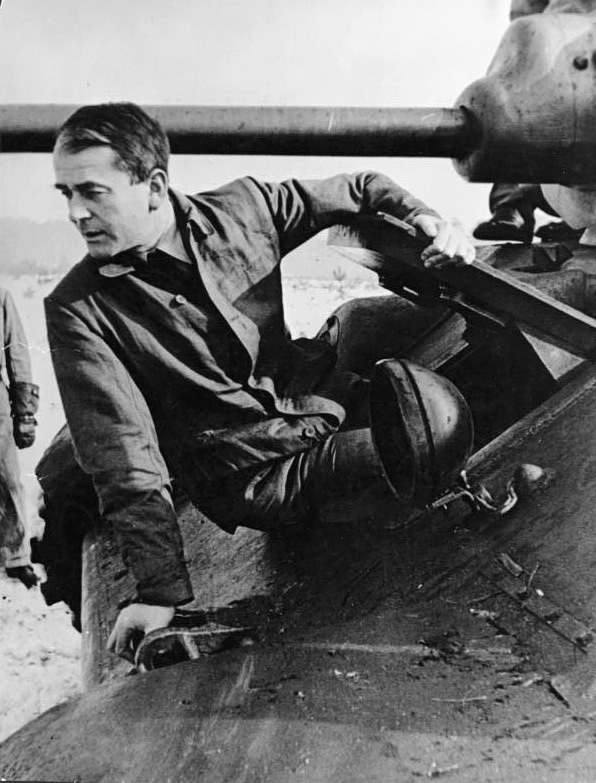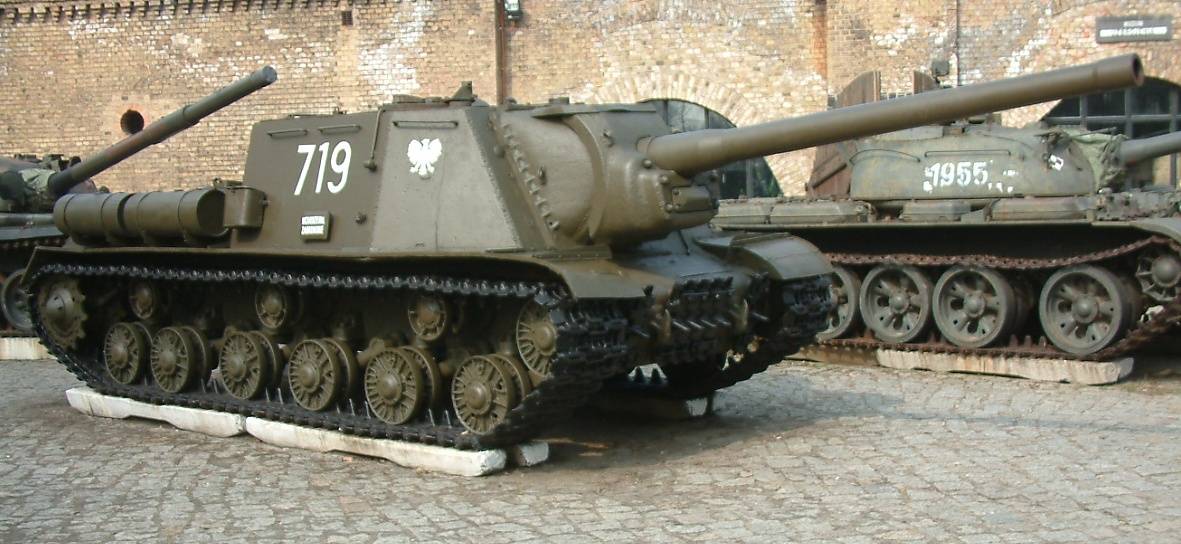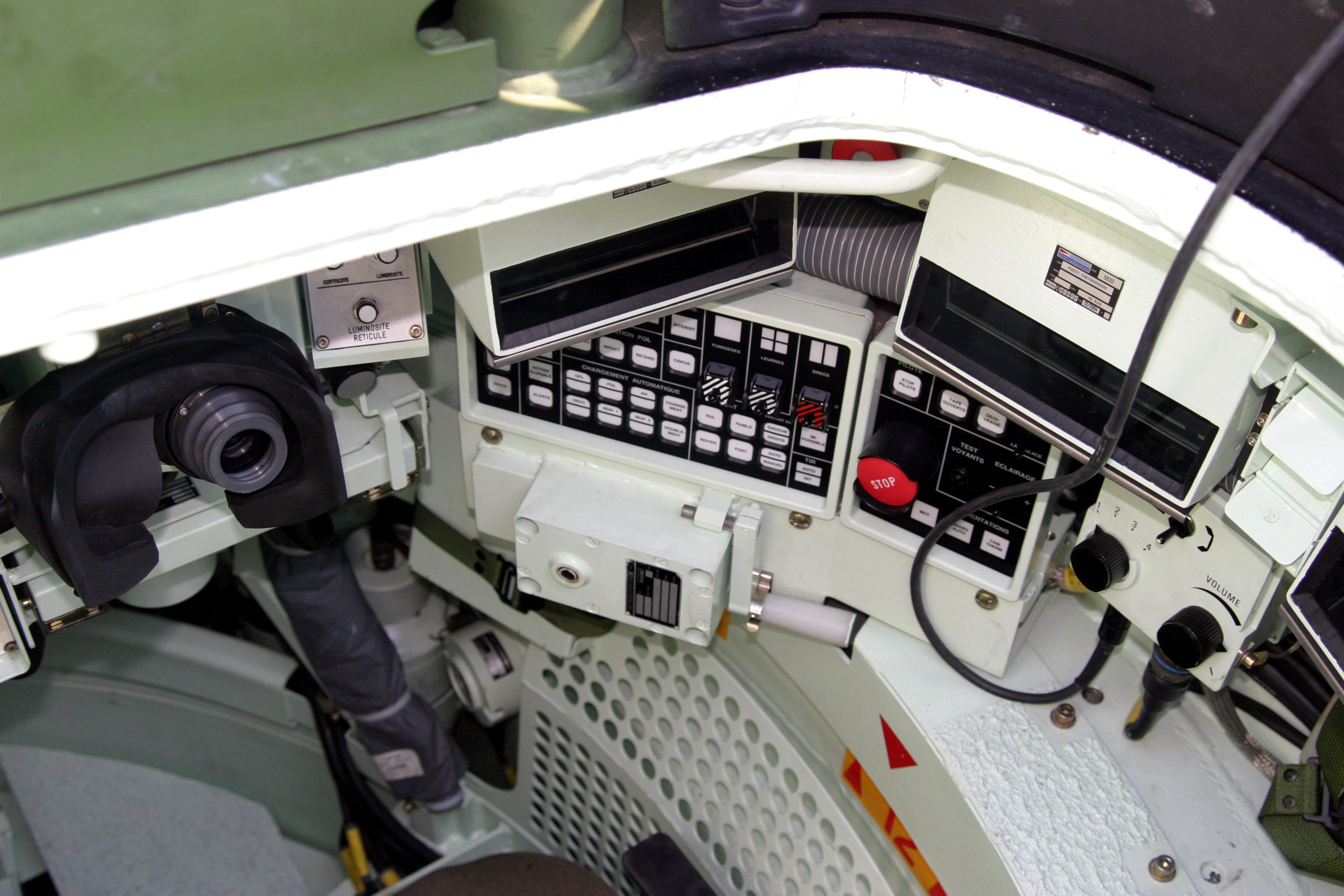|
Gun Mantlet
A gun mantlet is an armour plate or shield attached to an armoured fighting vehicle's gun, protecting the opening through which the weapon's barrel projects from the hull or turret armour and, in many cases, ensuring the vulnerable warhead of a loaded shell does not protrude past the vehicle's armour. On many tanks during World War II, the gun mantlet covered both the main gun and any coaxial armament, and had the thickest armour on the vehicle. However, in many late Cold War and post-Cold War tank designs, the gun mantlet became one of the weaker parts of a vehicle's turret armour and thus a weakness. This was because as many mantlet designs were attached directly to the gun, it drastically increased the weight of the whole gun system and the amount of effort needed to elevate and depress it. This was an issue for gun stabilizers as they proved to be less efficient and accurate in keeping the gun steady with the added weight of the mantlet. Therefore, as seen in tanks such a ... [...More Info...] [...Related Items...] OR: [Wikipedia] [Google] [Baidu] |
Gun Mantlet Of M1A1 Abrams
A gun is a ranged weapon designed to use a shooting tube (gun barrel) to launch projectiles. The projectiles are typically solid, but can also be pressurized liquid (e.g. in water guns/water cannon, cannons, spray nozzle, spray guns for spray painting, painting or pressure washing, projected water disruptors, and technically also flamethrowers), gas (e.g. light-gas gun) or even charged particles (e.g. plasma torch, plasma gun). Solid projectiles may be free-flying (as with bullets and artillery shells) or tethered (as with Taser guns, spearguns and harpoon guns). A large-caliber gun is also called a ''cannon''. The means of projectile propulsion vary according to designs, but are traditionally effected pneumatically by a high gas pressure contained within the barrel tube, produced either through the rapid exothermic combustion of propellants (as with firearms), or by mechanical compression (as with air guns). The high-pressure gas is introduced behind the projectile, pushing ... [...More Info...] [...Related Items...] OR: [Wikipedia] [Google] [Baidu] |
Panther Tank
The Panther tank, officially ''Panzerkampfwagen V Panther'' (abbreviated PzKpfw V) with ordnance inventory designation: ''Sd.Kfz.'' 171, is a German medium tank of World War II. It was used on the Eastern and Western Fronts from mid-1943 to the end of the war in May 1945. On 27 February 1944 it was redesignated to just ''PzKpfw Panther'', as Hitler ordered that the Roman numeral "V" be deleted. In contemporary English-language reports it is sometimes referred to as the "Mark V". The Panther was intended to counter the Soviet T-34 medium tank and to replace the Panzer III and Panzer IV. Nevertheless, it served alongside the Panzer IV and the heavier Tiger I until the end of the war. It had excellent firepower, protection and mobility, although its reliability was less impressive. The Panther was a compromise. While having essentially the same Maybach V12 petrol (690 hp) engine as the Tiger I, it had better gun penetration, was lighter and faster, and could traverse roug ... [...More Info...] [...Related Items...] OR: [Wikipedia] [Google] [Baidu] |
Gun Shield
A U.S. Marine manning an M240 machine gun equipped with a gun shield A gun shield is a flat (or sometimes curved) piece of armor designed to be mounted on a crew-served weapon such as a machine gun, automatic grenade launcher, or artillery piece. Military Some mounted machine guns and artillery pieces are equipped with metal armor plates to protect the gunners from small arms fire and shrapnel from explosions. They were fitted to some armored fighting vehicles and patrol boats during the Vietnam War. Gun shields fell out of widespread use after the Vietnam war, but they have seen a resurgence in popularity during the 1990s. Israeli military analysts began urging the use of gun shields, pointing to the grave risk to soldiers exposed to fire from automatic weapons. In particular, it was noted that many casualties were hit in areas not protected by body armor or a helmet, such as the neck or face. The U.S. began using gun shields during the 2000s-era wars in Iraq and Afghanista ... [...More Info...] [...Related Items...] OR: [Wikipedia] [Google] [Baidu] |
ISU-122
The ISU-122 (acronym of'' Istrebitelnaja - or Iosif Stalin-based - Samokhodnaya Ustanovka 122'') was a Soviet assault gun used during World War II, mostly in the anti-tank role. History and purpose A prototype of the ISU-122 (in Russian ИСУ-122) heavy self-propelled gun was built at the Chelyabinsk Kirov Plant (''Chelyabinskiy Kirovskiy Zavod (ChKZ)'', Chelyabinsk, Russia), in December 1943. The design shared the chassis of the ISU-152 self-propelled gun and differed only in armament, having an A-19S 122-mm gun as its main weapon instead of the ISU-152's ML-20S gun-howitzer. Towed versions of these guns used the same carriage: 52-L-504A (Russian designation 52-Л-504А), so installation of an A-19 instead of an ML-20 gun was not a difficult task. After completing development of the ISU-152, ChKZ engineers mounted the A-19 gun on the ISU-152 chassis to create ''"Object 242"'' — the first ISU-122 prototype. It was successfully tested, but not immediately launched into mass p ... [...More Info...] [...Related Items...] OR: [Wikipedia] [Google] [Baidu] |
Jagdpanther
The ''Jagdpanther'' (German: "hunting Panther"), Sd.Kfz. 173, was a tank destroyer (''Jagdpanzer'', a self-propelled anti-tank gun) built by Germany during World War II. The ''Jagdpanther'' combined the 8.8 cm Pak 43 anti-tank gun, similar to the main gun of the Tiger II, and the armor and suspension of the Panther chassis. It entered service in 1944 and served on the Eastern and Western Fronts. During the last stages of the war, limited German production resulted in small production numbers, shortage of spare parts, and shortened crew training periods of younger operators. Development The Jagdpanther was preceded by two attempts at mounting an 8.8 cm gun as a self-propelled anti-tank weapon; ''Ferdinand'' - also known as ''Panzerjäger Tiger'' (P) - using the ninety-one leftover Porsche-built VK 45.01 (P) chassis from the Tiger tank competition it lost to Henschel in 1942, and the ''Nashorn'' on the Geschützwagen III/IV (which used a combination of the Panzer ... [...More Info...] [...Related Items...] OR: [Wikipedia] [Google] [Baidu] |
Sturmgeschütz III
The ''Sturmgeschütz III'' (StuG III) assault gun was Germany's most-produced fully tracked armoured fighting vehicle during World War II, and second-most produced German armored combat vehicle of any type after the Sd.Kfz. 251 half-track. It was built on a slightly modified Panzer III chassis, replacing the turret with an armored, fixed superstructure mounting a more powerful gun. Initially intended as a mobile assault gun for direct-fire support for infantry, the StuG III was continually modified, and much like the later ''Jagdpanzer'' vehicles, was employed as a tank destroyer. Development The '' Sturmgeschütz'' originated from German experiences in World War I, when it was discovered that, during the offensives on the Western Front, the infantry lacked the means to engage fortifications effectively. The artillery of the time was heavy and not mobile enough to keep up with the advancing infantry to destroy bunkers, pillboxes, and other minor fortifications with direct ... [...More Info...] [...Related Items...] OR: [Wikipedia] [Google] [Baidu] |
Leclerc Tank
The Leclerc is a third generation French main battle tank developed and manufactured by Nexter Systems. It was named in honor of Marshal Philippe Leclerc de Hauteclocque, a commander of the Free French Forces, who led the 2nd Armoured Division in World War II. The Leclerc is in service with the French Army, Jordanian Army and the United Arab Emirates Army. In production since 1991, the Leclerc entered French service in 1992, replacing the AMX 30 as the country's main armoured platform. With production now complete, the French Army operates 222 Leclercs (with 184 more in storage for a total of 406), while the United Arab Emirates Army possesses 388. Of the units in French service, 200 will be upgraded to the XLR standard with deliveries expected to begin in 2022. History In 1964, studies were initiated about a possible replacement vehicle for the AMX-30 main battle tank: the ''Engin Principal Prospectif''. In 1971, in view of the inferiority of the AMX 30 in comparison to the n ... [...More Info...] [...Related Items...] OR: [Wikipedia] [Google] [Baidu] |
T-70
The T-70 was a light tank used by the Red Army during World War II, replacing both the T-60 scout tank for reconnaissance and the T-50 light infantry tank for infantry support. The T-80 light tank was a more advanced version of the T-70 with a two-man turret—it was produced only in very small numbers when light tank production was abandoned. The T-90 self-propelled anti-aircraft gun was a prototype vehicle with twin machine guns, based on the T-70 chassis. The T-70 was armed with a 45-mm L/46 gun Model 38 with forty-five rounds carried, and a coaxial 7.62-mm DT machine gun. The tank was operated by a driver and a commander who loaded and fired the gun. Armour thickness on the turret front was 60 mm, turret sides and rear: 35 mm, hull front and sides: 45 mm, roof and bottom: 10 mm. Production history By 1942, light tanks were considered inadequate by the Red Army, unable to keep up with the T-34 medium tank and unable to penetrate the armour of most ... [...More Info...] [...Related Items...] OR: [Wikipedia] [Google] [Baidu] |
Comet Tank
The Comet tank or Tank, Cruiser, Comet I (A34) was a British cruiser tank that first saw use near the end of the Second World War, during the Western Allied invasion of Germany. The Comet was developed from the earlier Cromwell tank and mounted the new 17 pdr High Velocity (HV) (3 inch; 76.2 mm – sometimes referred to as "77 mm") gun, in a lower profile, partly-cast turret. This gun was effective against late-war German tanks, including the Panther at medium range, and the Tiger. The Comet rendered the Cruiser Mk VIII Challenger obsolete, and led to the development of the Centurion tank. When firing APDS rounds, the 77 mm HV was superior in armour penetration capability to the 75 mm KwK 42 gun of the equivalent Axis tank, the Panther. The Comet entered active service in January 1945 and remained in British service until 1958. In some cases, Comets sold to other countries continued to operate into the 1980s. Design and development Backg ... [...More Info...] [...Related Items...] OR: [Wikipedia] [Google] [Baidu] |
M4 Sherman
} The M4 Sherman, officially Medium Tank, M4, was the most widely used medium tank by the Military history of the United States during World War II, United States and Allies of World War II, Western Allies in World War II. The M4 Sherman proved to be reliable, relatively cheap to produce, and available in great numbers. It was also the basis of several other Armoured_fighting_vehicle, armored fighting vehicles including self-propelled artillery, Tank_destroyer, tank destroyers, and Armoured_recovery_vehicle, armored recovery vehicles. Tens of thousands were distributed through the Lend-Lease program to the British Empire#Second World War, British Commonwealth and Soviet Union. The tank was named by the British after the American Civil War General William Tecumseh Sherman. The M4 Sherman evolved from the M3 Lee, M3 Medium Tank, which for speed of development had its main armament in a side sponson mount. The M4 retained much of the previous mechanical design, but moved the 75_mm ... [...More Info...] [...Related Items...] OR: [Wikipedia] [Google] [Baidu] |
Tiger I
The Tiger I () was a German heavy tank of World War II that operated beginning in 1942 in Africa and in the Soviet Union, usually in independent heavy tank battalions. It gave the German Army its first armoured fighting vehicle that mounted the 8.8 cm KwK 36 gun (derived from the 8.8 cm Flak 36). 1,347 were built between August 1942 and August 1944. After August 1944, production of the Tiger I was phased out in favour of the Tiger II. While the Tiger I has been called an outstanding design for its time, it has also been called overengineered, using expensive materials and labour-intensive production methods. In the early period Tiger was prone to certain types of track failures and breakdowns and was in general limited in range by its high fuel consumption. It was expensive to maintain, but generally mechanically reliable. It was difficult to transport and vulnerable to immobilisation when mud, ice, and snow froze between its overlapping and interleaved ''Schacht ... [...More Info...] [...Related Items...] OR: [Wikipedia] [Google] [Baidu] |
Chieftain (tank)
The List of FV series military vehicles, FV4201 Chieftain was the main battle tank of the United Kingdom during the 1960s–1990s. A development of the Centurion tank, Centurion, the Chieftain introduced the supine (reclining) driver position to British design allowing a heavily sloped hull with reduced height. A new powerpack and improved transmission gave it higher speed than the Centurion despite being heavier due to major upgrades to armour protection and the armament; this allowed it to replace both the Conqueror (tank), Conqueror and Centurion (tank), Centurion while performing their roles effectively. It remained in service until replaced by the Challenger 1 which shared many of the Chieftain's features. Development The Chieftain was an evolutionary development of the successful cruiser tank, cruiser line of tanks that had emerged at the end of the World War II, Second World War. Its predecessor, the centurion tank, Centurion main battle tank (MBT), is widely considered to ... [...More Info...] [...Related Items...] OR: [Wikipedia] [Google] [Baidu] |



_Driver_and_Commander_from_A_Squadron%2C_3rd_Cavalry_Regiment.jpg)





.jpg)
